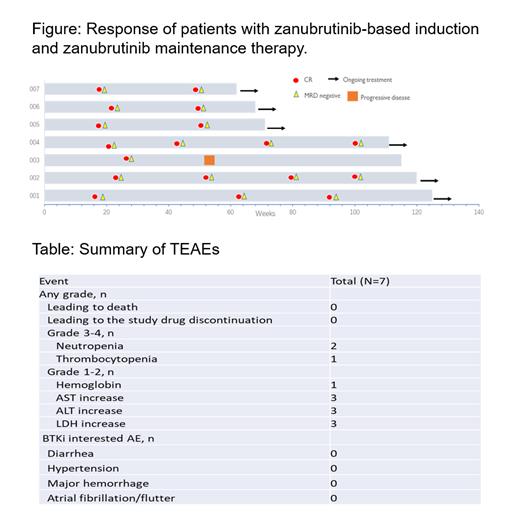Introduction
Studies showed that remission after induction therapy is associated with better prognosis in mantle cell lymphoma (MCL) patients, and minimal residual disease (MRD) is also considered as an independent and sensitive factor in MCL patients. As R-CHOP/R-DHAOx is the most common used induction regimen in China, we investigate the benefit of zanubrutinib-based induction (zanubrutinib plus R-CHOP) in untreated young MCL patients. We previously reported a promising result of an ORR of 100% with MRD negative rate of 100% after induction treatment in 2022 PPLC. Here, we reported a long-time (median follow-up: 25.9 months) efficacy and safety in the study.
Methods
In this prospective, single-center, single-arm, phase II study (NCT04736914), patients aged 18-65 years with previously untreated, Ann Arbor stage II-IV, histologically confirmed MCL will be enrolled to alternately receive R-CHOP + zanubrutinib and R-DHAOx induction for 6 cycles (every 21 days per cycle). Zanubrutinib will be administered in cycle 1, 3, 5 (R-CHOP), 160 mg BID, d1-21, and not in combination with R-DHAOx. Patients who achieve remission (≥PR) will be allowed to proceed to ASCT or maintenance depending on the investigator's evaluation and discretion. In patients who do not achieve a remission at the end of induction (treatment failure), no specific treatment is defined; rather, the further salvage treatment is upon the discretion of investigators. Patients will receive zanubrutinib maintenance for two years in case of remission at ASCT assessment or end of induction assessment. Zanubrutinib is administrated orally at 160 mg BID, continuously for 2 years or until progressive disease, unacceptable toxicity, or death, whichever occurs first. The primary endpoint was bone marrow MRD negative rate after induction therapy (at the completion of cycle 6 or at premature discontinuation).
Results
A total of 7 patients were enrolled, the median age was 56.3, and bone marrow (BM), peripheral blood (PB) MRD showed positive at baseline. After 6 cycles of R-CHOP + zanubrutinib and R-DHAOx induction treatment, BM and PB MRD negative rate was 100% (7/7). One patient proceeded to ASCT. At the data cut-off date of 30 Jun 2023, one patient has completed the study at week 53 with zanubrutinib maintenance treatment due to the progressive disease, while the other 6 patients remain in the zanubrutinib maintenance treatment and are still under follow-up (Figure). With a median follow-up of 25.9 months, all patients showed good tolerance, with no dose modification and discontinuation during zanubrutinib-based induction therapy, either no BTKi interested AE (includes diarrhea, hypertension, major hemorrhage, and atrial fibrillation/flutter) was observed (Table).
Conclusions
This prospective, phase II study with a relatively longer follow-up duration estimated the treatment regimen in untreated young MCL patients. At the time of data cut-off, zanubrutinib-based induction therapy was well tolerated in all patients and showed a promising results in response and MRD. With a median treatment duration of 16.6 months, most patients (6/7) did not relapse. The study is ongoing and further results will be continuously released.
Disclosures
No relevant conflicts of interest to declare.


This feature is available to Subscribers Only
Sign In or Create an Account Close Modal